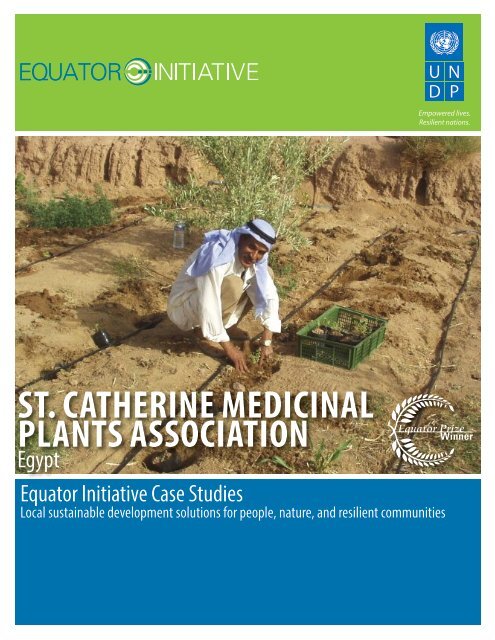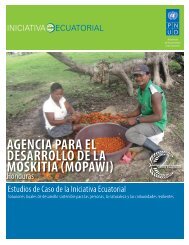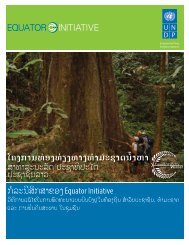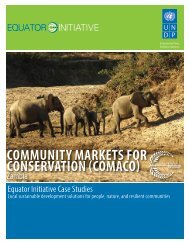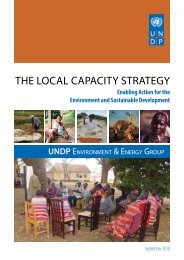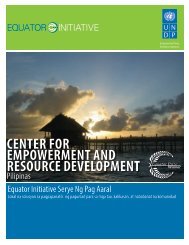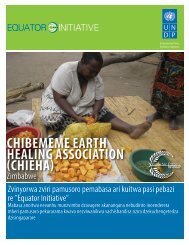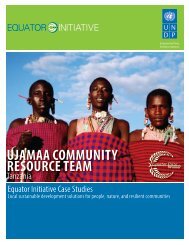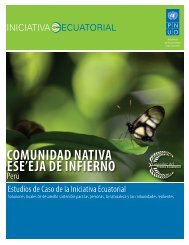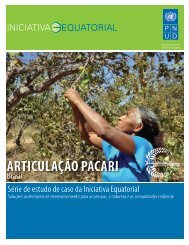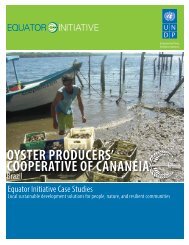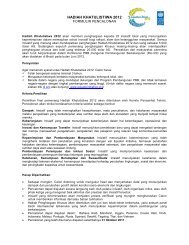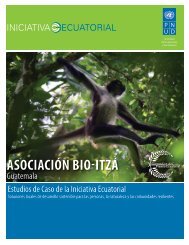st. catherine medicinal plants association - The GEF Small Grants ...
st. catherine medicinal plants association - The GEF Small Grants ...
st. catherine medicinal plants association - The GEF Small Grants ...
You also want an ePaper? Increase the reach of your titles
YUMPU automatically turns print PDFs into web optimized ePapers that Google loves.
this work has focussed on women community members. One of themain successes of the project has been in successfully promotingand marketing community produce, e<strong>st</strong>ablishing improved marketsupply chains and bringing in higher incomes for members. Beyondits initial focus, moreover, the <strong>association</strong> has evolved to meet a widerange of community needs, including providing su<strong>st</strong>ainable energyand micro-credit options.In designing St. Catherine Medicinal Plants Association, a scenarioplanning exercise was conducted by project <strong>st</strong>aff, bringing togethermo<strong>st</strong>ly local <strong>st</strong>akeholders for a 13-day workshop to facilitate opendiscussion and develop a framework for how a potential community<strong>association</strong> would operate. A value-chain development workshopwas held in parallel, to discuss barriers and solutions to optimizingthe market supply chain of the reserve’s <strong>medicinal</strong> <strong>plants</strong>. <strong>The</strong> visionthat emerged was one of full participation of all actors in the St.Catherine community at every <strong>st</strong>age of the production chain.In both the planning and implementation <strong>st</strong>ages of the initiative,the focus was placed on community ownership and leadership.All components of the initiative are owned by the community(represented through membership of the <strong>association</strong>) andcommunity members are involved in all aspects of the initiative’sactivities. Approximately 50 per cent of the Bedouin communitybenefits from the activities of the <strong>association</strong> through generationof employment opportunities and development of su<strong>st</strong>ainableincome. All told, it is e<strong>st</strong>imated that the <strong>medicinal</strong> <strong>plants</strong> valuechain e<strong>st</strong>ablished by St. Catherine Medicinal Plants Association issupporting the livelihoods of over 500 families.Governance of the <strong>association</strong>All eleven board members, as well as the entirety of <strong>association</strong><strong>st</strong>aff, are members of the St. Catherine community. <strong>The</strong> board meetsregularly to take decisions regarding the <strong>association</strong>’s activities. Alltechnical and admini<strong>st</strong>rative ideas are discussed by inviting localrepresentatives to participate in the meetings. Decisions aim totake into account the likely social, economic and environmentalimplications for the community. <strong>The</strong> <strong>association</strong> has done a greatdeal to advance the <strong>st</strong>atus of women by building their capacity,providing employment opportunities and involving women in thedecision-making process as board members. Indeed, executivemanagement of <strong>association</strong> activities is carried out by Bedouinwomen, setting a <strong>st</strong>rong precedent in a community where womenhave not traditionally been involved in public decision-making.Although conceived through a project under the aegis of theEnvironmental Affairs Agency, St. Catherine Medicinal PlantsAssociation is regi<strong>st</strong>ered as a non-governmental organization.<strong>The</strong> <strong>association</strong> is to a great extent financially self-su<strong>st</strong>aining,with revenues coming from annual subscription fees paid bymembers, profits accrued from a revolving loan programme, andthe commercial sale of <strong>medicinal</strong> <strong>plants</strong>, honey, handicrafts andcandles. All revenue accrues directly to community members,helping to reduce management expenses and increase returns.For its contribution to community development and conservation,the Governor of South Sinai has granted St. Catherine MedicinalPlants Association a building that serves as the hub of its activitiesand provides space for <strong>association</strong> members to meet and sell theirproducts.5
Key Activities and InnovationsConserving <strong>medicinal</strong> <strong>plants</strong> in the wildSt. Catherine Medicinal Plants Association has undertaken a rangeof activities to conserve the flora of the region, both through directconservation methods, and by developing alternative livelihoodopportunities to reduce pressure on wild <strong>plants</strong> from the activities ofthe local population. <strong>The</strong> <strong>association</strong>’s activities follow the principlesof community-based natural resource management, providing thecommunity with the necessary skills and training to su<strong>st</strong>ainablymanage their own resource base and develop meaningful alternativelivelihoods, rather than conserving local biodiversity at the expenseof community access to their resources.To reduce the environmental impact of <strong>medicinal</strong> plant collection forlocal use, community members are trained in methods for su<strong>st</strong>ainablycollecting wild <strong>plants</strong>, resulting in an observed improvementin the health and vitality of the local ecosy<strong>st</strong>em. Twelve organiccultivation sites have been e<strong>st</strong>ablished to develop techniques forthe dome<strong>st</strong>ication of wild <strong>medicinal</strong> <strong>plants</strong>. <strong>The</strong>se cultivation sitesalso function as demon<strong>st</strong>ration sites. A seed collection programmehas been e<strong>st</strong>ablished to conserve the region’s unique range of <strong>plants</strong>pecies. To preserve the di<strong>st</strong>inctive character of the region’s plant lifein situ, a project has been implemented to control invasive specie<strong>st</strong>hat threaten endemic <strong>medicinal</strong> <strong>plants</strong>. Under this project, measureshave also been taken to control the region’s feral donkeys that grazeon threatened <strong>plants</strong> and to address overgrazing by live<strong>st</strong>ock. To thisend, fodder lots have been provided for cattle.Developing alternative livelihood optionsAbove and beyond wild <strong>medicinal</strong> plant cultivation, St. CatherineMedicinal Plants Association is working to generate new sources ofincome and create new livelihood options for the local population.<strong>The</strong> aim is to diversify the local income base to reduce pressure onwild flora and to avoid the dangers of overreliance on a single sector oractivity. One way this has been accomplished is through the creationof household gardens and community farms, where <strong>medicinal</strong><strong>plants</strong> can be grown in a controlled, dome<strong>st</strong>icated environment. <strong>The</strong><strong>association</strong> has helped to e<strong>st</strong>ablish 25 community farms: 17 operatedby men and eight by women. <strong>The</strong> gardens and farms enable localpeople to plant and market organic food and to produce <strong>medicinal</strong><strong>plants</strong> dome<strong>st</strong>ically rather than harve<strong>st</strong>ing them from the wild. Thisinitiative has been particularly empowering for women, who havegenerally taken responsibility for these activities in their households.<strong>The</strong> gardens and farms are generating approximately EGP 500 (USD82) per month for each household involved.Alternative livelihood options are also being created through thedevelopment of a value chain for local plant resources. Trainingand inve<strong>st</strong>ment has been provided to begin manufacturing andmarketing cosmetic and artisanal products derived from local<strong>plants</strong>. Examples include soaps, candles and drawings of local <strong>plants</strong>on wood, paper and cloth. Production of these and other handicraftshas involved the participation of 600 individuals, each receivingan average of EGP 150 (USD 25) per month for their work, and hascreated 108 year-round jobs within the community. Meanwhile, twohundred beehives have also been di<strong>st</strong>ributed by the <strong>association</strong>,benefitting 15 households who between them produce about1,000 kg of high quality mountain honey each year, generating EGP200,000 (approximately USD 32,790) in revenue. Twenty-five percent of the revenue generated from honey production is returnedto the <strong>association</strong> and reinve<strong>st</strong>ed in other activities for the benefit ofthe wider community.Raising environmental awareness<strong>The</strong> <strong>association</strong> works to raise local environmental awareness,communicating the importance of biodiversity to the region’seconomic, environmental and social wellbeing. Environmentalawareness activities have helped improve community knowledge,particularly for those working in the ecotourism sector. Greaterawareness has translated to higher levels of participation in6
conservation activities. To engage the younger generation ofBedouin, the <strong>association</strong> recently held a successful campaignthrough the reserve’s Green School Programme, teaching 543<strong>st</strong>udents at 20 local schools about the importance of the region’splant biodiversity.Su<strong>st</strong>ainable energy, savings and loan services<strong>The</strong> creation of home gardens and community farms has helpedreduce dependence on wild <strong>plants</strong> for firewood; a dependencethat, in combination with population growth and relative economicdespair and isolation, was previously putting unsu<strong>st</strong>ainable pressureon local ecosy<strong>st</strong>ems. <strong>The</strong>se interventions have been complementedby the promotion of solar energy and the provision of gas oven<strong>st</strong>o community members. It is hoped that these efforts will meetcommunity energy needs while also protecting the environment.With the support of the Environmental Affairs Agency, eight solarcells have been placed in community public areas, including themosque, to promote awareness of renewable energy options. Effort<strong>st</strong>o provide access to su<strong>st</strong>ainable energy have been tied closely toa revolving loan programme, which has financed the purchase ofmany gas ovens and gas cylinders for household use. To date, morethan 500 Bedouin families have benefited from the micro-creditprogramme, which has financed 25 gas ovens, 275 gas cylinders,and a significant number of beehives, solar heaters and dome<strong>st</strong>icplant gardens.<strong>The</strong> revolving loan programme is central to the changes the<strong>association</strong> is attempting to catalyse in the region. It functions asmany micro-credit programmes do, providing local households withfinances to inve<strong>st</strong> in small businesses ventures, su<strong>st</strong>ainable energysolutions, or income diversification projects. <strong>The</strong> main project criteriafor accessing the revolving loan resources is any initiative that helpreduce pressure on the region’s <strong>medicinal</strong> <strong>plants</strong>, the environmentand ecosy<strong>st</strong>em services.Overall, the initiative has contributed to the development of asu<strong>st</strong>ainable value-added chain for the marketing of <strong>medicinal</strong><strong>plants</strong> in St. Catherine’s Reserve. From harve<strong>st</strong>ing to value-addedsecondary processing to sales (in local, regional and global markets),the initiative has helped to transform the local economy and thelocal landscape.7
ImpactsBIODIVERSITY IMPACTSSt. Catherine’s Reserve is an ecologically unique area. It containsalmo<strong>st</strong> half of Egypt’s endemic plant species, including asignificant number of <strong>medicinal</strong> and aromatic <strong>plants</strong>. <strong>The</strong> highdegree of endemism among Sinai plant species means that – withmismanagement or continued overexploitation – local extinctionwould also mean global extinction. Many local species are alreadyendangered. As one example, fewer than 100 Rosa Arabica <strong>plants</strong>remain in the high mountains.St. Catherine Medicinal Plants Association has done a great dealto increase local awareness of the unique ecology in the region, aswell as appreciation for how the burden of <strong>st</strong>ewardship that fall<strong>st</strong>o the community can also create economic opportunity and newbenefit <strong>st</strong>reams. <strong>The</strong> <strong>association</strong> has been judicious and balancedin its emphasis on the social, environmental, economic and culturalvalue that can be found in a healthy ecosy<strong>st</strong>em and in a communitythat protects and rejuvenates its unique concentration of <strong>medicinal</strong><strong>plants</strong>. Job creation, new livelihoods and higher tourism revenuesprovide the cleare<strong>st</strong> incentive for local action, and demon<strong>st</strong>ratingthis economic upside has been an important cataly<strong>st</strong> of conservationactivities. Pressure on wild <strong>plants</strong> has been mitigated throughtraining in su<strong>st</strong>ainable management and the provision of alternativelivelihood options. <strong>The</strong>re has been a noticeable improvement in thecondition of wild <strong>plants</strong> as a result of the <strong>association</strong>’s conservationmeasures.Holi<strong>st</strong>ic land management and environmental awarenessAnother biodiversity impact from the initiative has been successfullyaddressing the overgrazing of live<strong>st</strong>ock, a ‘tragedy of the commons’situation that was leading to land degradation, the loss ofthreatened <strong>medicinal</strong> and aromatic <strong>plants</strong>, and resource conflicts.Dedicated areas for live<strong>st</strong>ock rearing, and corresponding areas forplant cultivation, have created more thoughtful and harmoniousland management practices that have also reduced pressure on wild<strong>plants</strong>. As part of a new land use planning approach, the <strong>association</strong>has also e<strong>st</strong>ablished re<strong>st</strong>oration sites: demarcated ecological zoneswhere no resource extraction is allowed, giving threatened <strong>medicinal</strong>plant species a chance to recover and thrive. La<strong>st</strong>ly, the <strong>association</strong>has made efforts to control invasive alien species, which also pose athreat to endemic <strong>plants</strong>.Environmental awareness campaigns have effectively raised localconsciousness of key threats to local ecosy<strong>st</strong>ems and the importanceof biodiversity to the local economy, not lea<strong>st</strong> of which to the tourismsector: St. Catherine’s Reserve receives an e<strong>st</strong>imated 300,000 visitorsevery year. Importantly, these campaigns have been linked to thepublicizing of tangible economic benefits, including the creation ofjobs in the areas of honey production, soap and candle production,and farming. As a result, the community feels it has a <strong>st</strong>ake inconserving the region’s flora, and that ecosy<strong>st</strong>em health is directlylinked to their own wellbeing.SOCIOECONOMIC IMPACTS<strong>The</strong> Medicinal Plants Association has ensured that the localcommunity, with its traditional reliance on the region’s naturalresources, has remained central to its <strong>st</strong>rategy to preserve the area’<strong>st</strong>hreatened <strong>medicinal</strong> <strong>plants</strong>. Rather than conserving endemic<strong>plants</strong> at the expense of the local population by re<strong>st</strong>ricting acces<strong>st</strong>o the reserve, for in<strong>st</strong>ance, the provision of gainful and reliableemployment options has been key to the programme model, and isan important element of its success to date. By developing incomegenerationopportunities that depend on the long-term healthof local ecosy<strong>st</strong>ems and diversity of plant species, the Bedouincommunity has been given a <strong>st</strong>rong <strong>st</strong>ake in the conservation andsu<strong>st</strong>ainable management of their local plant resources. Beyondcreating incentives, the <strong>association</strong> has prioritized communityinve<strong>st</strong>ment in the project and ownership over decision-making andgovernance.8
Income generation and employment opportunities have benefitedmore than half of the local community. In total, the initiative hascreated 108 new permanent jobs. <strong>The</strong> e<strong>st</strong>ablishment of <strong>medicinal</strong>plant farms and the development of honey production andhandicrafts and plant-derived products indu<strong>st</strong>ries have togetherboo<strong>st</strong>ed household and individual incomes significantly. <strong>The</strong>community has collectively achieved a new level of economicresilience. By diversifying incomes, the initiative has reducedcommunity vulnerability to economic and environmental shocks,including the erratic rainfall patterns in the region which underminetraditional livelihoods such as grazing and collection of wild <strong>plants</strong>.By contra<strong>st</strong>, the activities promoted by the <strong>association</strong> are lessweather-dependent and can be undertaken year-round.Empowerment of women<strong>The</strong> bigge<strong>st</strong> socioeconomic impact of the <strong>association</strong>’s work is itscontribution to the empowerment of Bedouin women and theprovision of employment opportunities where previously fewexi<strong>st</strong>ed. Local employment opportunities for women were sparse atbe<strong>st</strong>, and since Bedouin tradition does not permit women to leavethe community to live alone in cities where they might seek workor pursue further education, financial independence and economicopportunity were traditionally out of reach. <strong>The</strong> <strong>association</strong> haschanged this by basing its programmes and activities primarilyaround the women of the community.POLICY IMPACTSAt the national level, the <strong>association</strong>’s work has played into thedevelopment of a regulatory framework for Access and BenefitSharing (ABS), developed by the Egyptian Mini<strong>st</strong>ry of Foreign Affairsin conjunction with other mini<strong>st</strong>ries involved in trade and intellectualproperty rights. <strong>The</strong> framework aims to promote the conservationand su<strong>st</strong>ainable use of wild <strong>medicinal</strong> <strong>plants</strong> and their habitats aswell as preserve the traditional knowledge associated with their use.<strong>The</strong> <strong>st</strong>rategy adopts the mission of preserving Egypt’s wealth of<strong>medicinal</strong> <strong>plants</strong> and related traditional knowledge through rationalmanagement and su<strong>st</strong>ainable use with the participation of all<strong>st</strong>akeholders. It also aims to fo<strong>st</strong>er in communities that have beenthe traditional <strong>st</strong>ewards of these resources an under<strong>st</strong>anding of thebenefits that can accrue to them from the su<strong>st</strong>ainable managementand conservation of their local resource base. <strong>The</strong> framework makespossible the setting of regulations and benefit-sharing arrangementswith in<strong>st</strong>itutions that might commercially exploit <strong>medicinal</strong> <strong>plants</strong>.<strong>The</strong> experience of St. Catherine Medicinal Plants Association hasbeen presented to the Cabinet of Mini<strong>st</strong>ers in Egypt as a model forhow the conservation of protected areas generate employment andincome for local communities that live in these reserves.Women represent the majority of wild <strong>plants</strong> collectors. In addition,eight of the community farms in which <strong>medicinal</strong> <strong>plants</strong> and foodcrops are dome<strong>st</strong>icated are operated by women. A programmewhich oversees the development and marketing of produceharve<strong>st</strong>ed from these farms is also managed by women, who receivea monthly income for their work and are helping to create a platformthat provides other local women with a new income <strong>st</strong>ream.Approximately 150 Bedouin women receive income from the saleof handicrafts through <strong>association</strong>’s sales outlets. Importantly, the<strong>association</strong> provides opportunities for women to work from theirhomes and fit their employment around their household schedules.Local women have also received loans from the community revolvingfund to purchase gas ovens and cylinders. So too, women have beenactively involved in the governance of the <strong>association</strong>. Women sit onthe Board of Directors, and are taking part in community decisionmakingprocesses alongside men for the fir<strong>st</strong> time.“Local communities are the protectors of the environment and the basis of development.Community-based organizations are like children who fir<strong>st</strong> need help to <strong>st</strong>and up, but then, oncegiven a little bit of support, can walk the re<strong>st</strong> of the way. Policy makers should and mu<strong>st</strong> workwith them and for them.”Mr. Adel Abd Alla Soliman, Manager, Medicinal Plants Conservation Project9
Su<strong>st</strong>ainability and ReplicationSUSTAINABILITYSt. Catherine Medicinal Plants Association was set up with the supportof the Environmental Affairs Agency’s Medicinal Plants ConservationProject, but today possesses the technical, admini<strong>st</strong>rative andfinancial capacities to function independently. Support from UNDP-<strong>GEF</strong> is in the process of being phased out and the initiative now relieson its own income-generating activities to fund its endeavours.A long-term su<strong>st</strong>ainability operations plan has been e<strong>st</strong>ablishedencompassing all programmes and activities. <strong>The</strong> plan lays out atimetable for proposed activities, the funding required for each,methods of procuring the resources necessary to carry these out, andproposed management arrangements. Funding for the <strong>association</strong>’sactivities comes from the proceeds of the sale of artisanal products,mountain honey and <strong>plants</strong>, as well as from profits accrued from therevolving loan scheme. <strong>The</strong> provision of a headquarters building forthe <strong>association</strong> by the South Sinai Governorate, meanwhile, has alsocontributed to financial su<strong>st</strong>ainability by reducing the <strong>association</strong>’soverhead expenses.<strong>The</strong> <strong>association</strong> has received international accreditation in theform of an Environmental Compliance Certificate for the collectionof <strong>plants</strong>, organic farming and trading of <strong>medicinal</strong> <strong>plants</strong> fromthe Mediterranean In<strong>st</strong>itute of Certification in Italy. A set of officialcooperation protocols with governmental agencies such as theMini<strong>st</strong>ry of the Environment and the Centre for Desert Research also<strong>st</strong>rengthens the <strong>association</strong>’s credibility.REPLICATIONPlans are underway for the expansion of the project, including theacquisition of more land on which to cultivate <strong>medicinal</strong> <strong>plants</strong>,and tapping new and emerging markets for the sale of locally madeproducts. A website has been created to showcase the <strong>association</strong>’swork, which has increased demand for its products and in turnencouraged the community to increase its scope and ambition.Beyond local expansion, the initiative has the potential to serve as amodel for sound, community-based natural resource managementacross the region and beyond. <strong>The</strong> <strong>association</strong> currently works withthe large<strong>st</strong> and mo<strong>st</strong> influential of South Sinai’s seven Bedouintribes and as such it has the potential to be replicated through thee<strong>st</strong>ablishment of similar initiatives with the six other tribes thatinhabit the reserve.Communities from other parts of Egypt, including Al-Jimal Valleyat the Red Sea and Shalateen in southern Egypt, have alreadyexpressed intere<strong>st</strong> in replicating the <strong>association</strong>’s work and havebegun to in<strong>st</strong>itute some activities inspired by the success of the St.Catherine initiative. <strong>The</strong> <strong>association</strong> organized a series of visits torepresentatives of these communities to explain the initiative, itsobjectives and the positive impacts it has had on the communities ofSt. Catherine’s Reserve. Partnership with the Mini<strong>st</strong>ry of Environmentplayed a large role in supporting the replication of the initiativeto these areas through the provision of the technical <strong>st</strong>aff andequipment necessary for the propagation of <strong>medicinal</strong> <strong>plants</strong>.<strong>The</strong> <strong>association</strong> is an active participant in the UNDP-implemented<strong>GEF</strong> <strong>Small</strong> <strong>Grants</strong> Programme (SGP) Network in Egypt, anotherchannel through which its work has been spread to other regions.Through a UNDP-<strong>GEF</strong> project on Conservation and Su<strong>st</strong>ainable Useof Medicinal Plants, the <strong>association</strong> has served as an example toother communities, with UNDP-<strong>GEF</strong> arranging for representativesof communities in other protected areas of similar conditions to St.Catherine to visit the Medicinal Plants Association to learn about itswork in the hope of encouraging replication.<strong>The</strong> <strong>association</strong> has generally taken a proactive approach toknowledge sharing, producing and making available through itswebsite policy papers that provide overviews of its processes. <strong>The</strong>seinclude papers on threat analysis, scenario planning, communitybasednatural resource management, and in situ ecosy<strong>st</strong>em10
ehabilitation. <strong>The</strong>se papers provide a means for the project totransfer its knowledge and share examples of be<strong>st</strong> practice forreplication elsewhere.PARTNERS<strong>The</strong> UNDP-implemented <strong>GEF</strong> <strong>Small</strong> <strong>Grants</strong> Programme providedseed funding for the project as well as capacity building for the<strong>association</strong>’s elected board members. <strong>The</strong> grant also went toward<strong>st</strong>raining community members in the cultivation of <strong>medicinal</strong> <strong>plants</strong>and improving the quality and marketing of their products.<strong>The</strong> <strong>association</strong> operates under a cooperation protocol withthe Mini<strong>st</strong>ry of the Environment (MOE) and is implemented inpartnership with the mini<strong>st</strong>ry, as represented by the managementof St. Catherine’s Reserve. <strong>The</strong> protocol defines the responsibilitiesand obligations of the MOE to provide the Medicinal PlantsAssociation with the in<strong>st</strong>ruments and tools needed to cultivate andpropagate <strong>medicinal</strong> <strong>plants</strong> as well as the operating expenses of thegreenhouses. <strong>The</strong> MOE also provides the necessary technical supportfor the operation of these greenhouses by providing qualifiedengineers to follow the plant propagation processes. <strong>The</strong> protocoldefines the responsibilities and obligations of the <strong>association</strong> in theuse of <strong>medicinal</strong> <strong>plants</strong> seedlings, to be grown within the area of St.Catherine, both in dome<strong>st</strong>ic farms or farms owned by the <strong>association</strong>.It determines the types of <strong>medicinal</strong> <strong>plants</strong> allowed for marketing aswell as other species which are not permitted to be commercializeddue to their conservation <strong>st</strong>atus.<strong>The</strong> South Sinai Governorate provides the <strong>association</strong> with itsheadquarters building, while there is close cooperation betweenthe <strong>association</strong> and the Desert Research Centre of Egypt. ResearchCentre <strong>st</strong>aff members provide advanced technical training tomembers of the <strong>association</strong> on techniques for su<strong>st</strong>ainable collectionof wild <strong>plants</strong>. Finally, the <strong>association</strong> also cooperates with the RedSea Protected Areas Development Association in implementingtheir biodiversity awareness activities for children.“Wealth is in the hands of communities and lies in our natural resources. We mu<strong>st</strong> teach ourchildren how to preserve the environment. Do not lose hope. With hard work and determination,we will achieve success for people and the environment.”Mr. Adel Abd Alla Soliman, Manager, Medicinal Plants Conservation Project11
FURTHER REFERENCE• St. Catherine Medicinal Plants Association Equator Initiative profile page on equatorinitiative.org• Medicinal Plants Conservation Project website: mpcpegypt.org/English/Global/index.aspxClick the thumbnails below to read more case <strong>st</strong>udies like this:Equator InitiativeEnvironment and Energy GroupUnited Nations Development Programme (UNDP)304 Ea<strong>st</strong> 45th Street, 6th FloorNew York, NY 10017Tel: +1 646 781-4023www.equatorinitiative.orgUNDP partners with people at all levels of society to help build nations that can with<strong>st</strong>and crisis, and drive and su<strong>st</strong>ain the kindof growth that improves the quality of life for everyone. On the ground in 177 countries and territories, we offer global perspectiveand local insight to help empower lives and build resilient nations.<strong>The</strong> Equator Initiative brings together the United Nations, governments, civil society, businesses and grassroots organization<strong>st</strong>o recognize and advance local su<strong>st</strong>ainable development solutions for people, nature and resilient communities.©2013 by Equator InitiativeAll rights reserved


